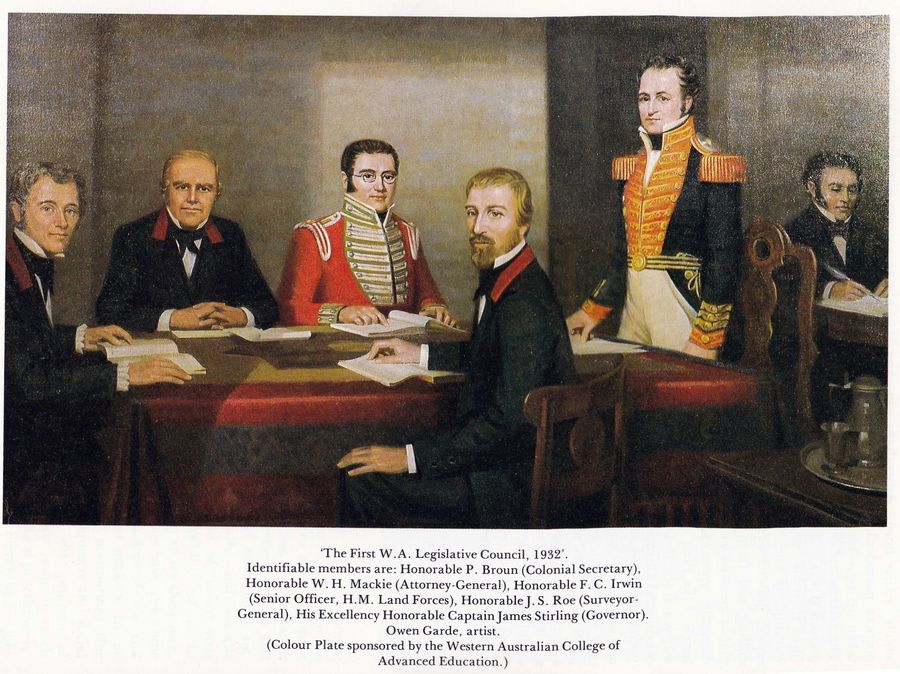|
Related pages : Governors of Western Australia | Premiers of Western Australia | Local
Government Websites
Initially the Governor had almost dictatorial powers with major policy being decided in far off London and the Colonial Office. Officially
Governor Stirling did not receive his appointment until 18 months after the settlers arrived
and for the intervening time had no actual right to issue edicts.
A legislative Council and Executive Council were established in 1832 but both were under the authority of the Governor.

(Note the incorrect date on the picture).
This system of taxation without representation (a situation that sparked the American War of Independence) was to continue for another 40 years. (Today we seem to have taxation with mis-representation.)
By 1859 all the other established colonies in Australia had their own parliaments. In 1865 and in 1869 Western Australia petitioned he British government for the right to have elected representatives
in the Legislative Council.
The British government originally wanted W.A. split into two states (along the 26th parallel) as it was thought that the population was too sparse and the area too large to be governed just from
Perth.
The Legislative Council was initially a 15 member appointed body but when the state's non-Aboriginal population reached 60,000 it was changed to an elected body.
When the Executive council was disbanded its members were given life long pensions in compensation. ('feather bedding' is still alive and well today.) How many other workers get a pension every time they are
made redundant?
In 1870 Representative Government was established. This effectively meant that the colony was on the road to self government and that England was taking less financial responsibility for its upkeep. The Governor
still had the power at this stage to veto the Legislative Council's decisions.
In 1877 the Legislative Council voted in favour of self government and a constitution was drafted and sent to London for approval. The House of Commons passed the Constitution Bill in 1890. Governor
Robinson proclaimed the Constitution on October 21st 1890. On December 22nd 1890
John Forrest was asked to form the first responsible government. The members were: John Forrest,
Septimus Burt, George Shenton, W. E. Marmion and H. W. Venn.
On July 31st 1900 Western Australians voted on joining an Australian federation and the 'yes' votes won by a majority of 44,800 to 19,691. This was also the first time women voted and 16,760 took
part. In 1901 Australia became an independent nation and Western Australia was a self governing state within the federation.
In 1933 there was an attempted secession in which the majority of the population of W.A. voted in favour of separating from the Eastern states.
Contrary to popular opinion we do not live in a democracy. We live under what can only be described as an elected oligarchy. We have elections from time to time but only one of two major parties
ever gets elected and the members of each party are not usually free to vote on issues as they choose.
In the early days you could not vote if you were female and could not vote if you did not hold property to a certain value. This ensured that only wealthy men were allowed to have a say in who was
elected. Few people are aware of the fact that these property voting restrictions did not end for the Legislative Council until 1964!
Aboriginal people were not given the right to vote until 1962 and it became compulsory to vote in 1963. In 1970 the minimum age for an elector dropped from 21 years of age to 18.
The state, like the country as a whole, has a lower house (Legislative Assembly) that enacts legislation and an upper house (Legislative Council) that is supposed to act as a house of review.
The Premier is the leader of the party with the majority of elected members in the lower house.
The country has three levels of government, Federal, State and Local. It is currently compulsory to vote in Federal and State elections but not in local council elections. Australia is the only English
speaking country in the world to have compulsory voting. Our view is that compulsory voting should be abolished.
The Governor of the state no longer has the powers that Governor Stirling started out with. Today the Governor is the representative of Australia's current monarch and performs constitutional and
ceremonial duties such as issuing writs for elections, appointing Ministers, Judges, Magistrates and J.Ps, and signing acts of parliament to officially make them law.
The Governor does have what are called 'Reserve Powers'. These can be called into force if the government begins to act in an illegal manner. For example, refusing to relinquish power after
defeat in an election.
Our longest serving Premier (to date) is David Brand who was Premier for 12 years and 1 day. The honour for shortest serving Premier goes to Hal Pateshall Colebatch who served just 30 days.
In Western Australia (and of course the rest of Australia too) the roles of religion, government and law are all separated. On some occasions Royal Commissions are held by government to
look into various issues. A Commissioner is appointed by the Governor and these bodies can have wide ranging scope and powers.
A brief time line of government in W.A.
|
Year
|
Event
|
|
1832
|
Legislative Council established.
|
|
1834
|
Legislative Council meetings are open to the public.
|
|
1839
|
4 non official members appointed to the Legislative Council.
|
|
1850
|
Legislative Council empowered to become an elected body.
|
|
1856
|
British Treasury no longer funds civil government in W.A.
|
|
1867
|
2 more non official members appointed to the Legislative Council.
|
|
|
First Legislative Council elections held in 5 of the 6 regions.
|
|
1870
|
New constitution. Legislative Council consists of 3 members appointed by the Governor, 3 officials and 12 elected members.
|
|
|
Representative Government established.
|
|
1879
|
Secret ballots introduced for Legislative Council elections.
|
|
1890
|
Constitution proclaimed (October 21) John Forrest becomes the 1st Premier (22nd December)
|
|
1893
|
Legislative Council becomes a 21 member elected body.
|
|
|
Legislative Assembly increased from 3 to 33 members.
|
|
1896
|
Legislative Assembly increased to 44 members.
|
|
1899
|
Legislative Council becomes a fully elected body. (Eventually 34 members strong.)
|
|
|
Women are allowed to vote (catch is they can't vote for the Legislative Council if they don't own property - same applies to men.
Finally changed in 1964).
|
|
|
Legislative Assembly increased to 50 members.
|
|
1900
|
Electoral terms set at three years and members are paid a salary. (Electoral terms eventually become 4 years.)
|
|
1901
|
Western Australia becomes part of the Commonwealth of Australia. (January 1)
|
|
1920
|
Women allowed to stand as candidates.
|
|
1933
|
Attempted secession gets the required votes but goes no further.
|
|
1951
|
Aborigines with citizenship papers given the right to vote.
|
|
1964
|
Compulsory voting established. Australia is the only English speaking country to have compulsory voting.
|
|
1962
|
All Aborigines now given the right to vote.
|
|
1968
|
Legislative Assembly increased to 51 members.
|
|
1970
|
Minimum voting age brought down to 18.
|
|
1975
|
Legislative Assembly increased to 55 members.
|
|
1981
|
Legislative Assembly increased to 57 members.
|
|
2007
|
The Australian Labor party makes history by holding office in all states and federally. John Howard fails to make history by being second Prime Minister to lose
his own seat during a general election and the second longest serving Prime Minister after Menzies.
|
|
Today
|
The public hopes for better days.
|
Was granting women's suffrage a cynical ploy?
The question has been asked; Was female suffrage in 1899 simply a cynical political move to help sideline the votes of the goldfields? Giving women, who lived predominantly in the
city, the vote, would have effectively sidelined any vote made by those living in the goldfields not to join the federation. As it was the goldfields were not fairly represented in parliament.
This can be clearly seen from the fact that the goldfields had only 4 seats with 14118 electors and the city had 11 seats and 16569 electors.
|








